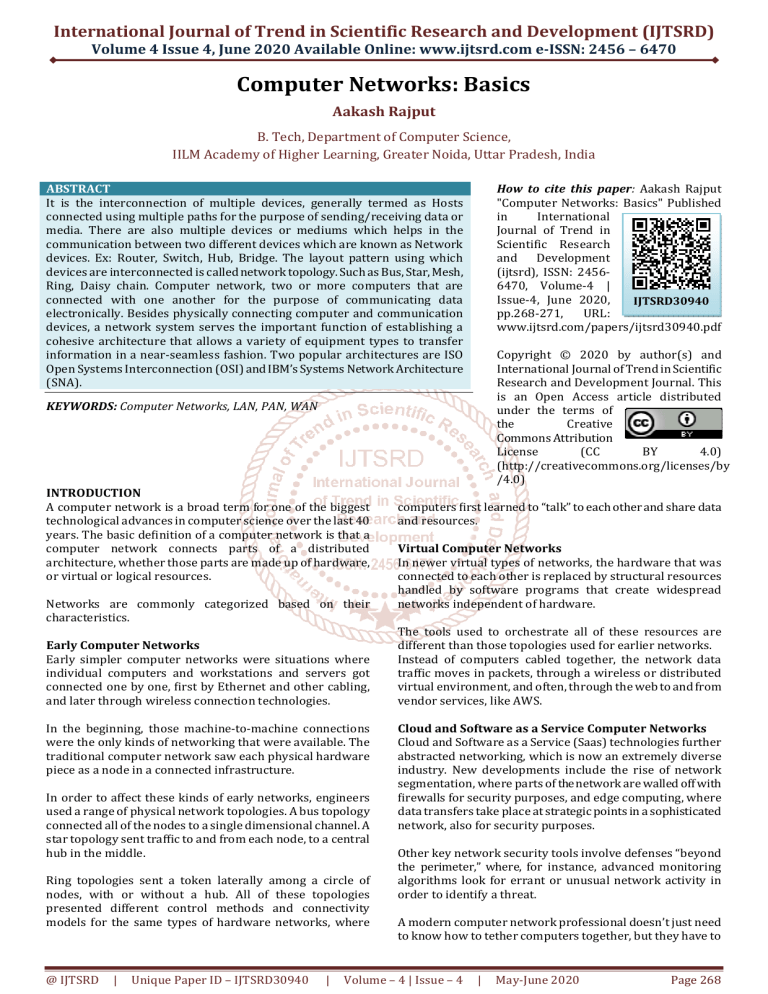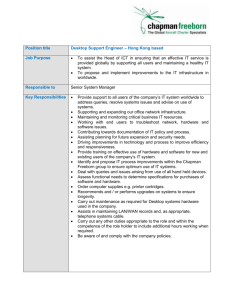
International Journal of Trend in Scientific Research and Development (IJTSRD) Volume 4 Issue 4, June 2020 Available Online: www.ijtsrd.com e-ISSN: 2456 – 6470 Computer Networks: Basics Aakash Rajput B. Tech, Department of Computer Science, IILM Academy of Higher Learning, Greater Noida, Uttar Pradesh, India How to cite this paper: Aakash Rajput "Computer Networks: Basics" Published in International Journal of Trend in Scientific Research and Development (ijtsrd), ISSN: 24566470, Volume-4 | Issue-4, June 2020, IJTSRD30940 pp.268-271, URL: www.ijtsrd.com/papers/ijtsrd30940.pdf ABSTRACT It is the interconnection of multiple devices, generally termed as Hosts connected using multiple paths for the purpose of sending/receiving data or media. There are also multiple devices or mediums which helps in the communication between two different devices which are known as Network devices. Ex: Router, Switch, Hub, Bridge. The layout pattern using which devices are interconnected is called network topology. Such as Bus, Star, Mesh, Ring, Daisy chain. Computer network, two or more computers that are connected with one another for the purpose of communicating data electronically. Besides physically connecting computer and communication devices, a network system serves the important function of establishing a cohesive architecture that allows a variety of equipment types to transfer information in a near-seamless fashion. Two popular architectures are ISO Open Systems Interconnection (OSI) and IBM’s Systems Network Architecture (SNA). Copyright © 2020 by author(s) and International Journal of Trend in Scientific Research and Development Journal. This is an Open Access article distributed under the terms of the Creative Commons Attribution License (CC BY 4.0) (http://creativecommons.org/licenses/by /4.0) KEYWORDS: Computer Networks, LAN, PAN, WAN INTRODUCTION A computer network is a broad term for one of the biggest technological advances in computer science over the last 40 years. The basic definition of a computer network is that a computer network connects parts of a distributed architecture, whether those parts are made up of hardware, or virtual or logical resources. Networks are commonly categorized based on their characteristics. Early Computer Networks Early simpler computer networks were situations where individual computers and workstations and servers got connected one by one, first by Ethernet and other cabling, and later through wireless connection technologies. In the beginning, those machine-to-machine connections were the only kinds of networking that were available. The traditional computer network saw each physical hardware piece as a node in a connected infrastructure. In order to affect these kinds of early networks, engineers used a range of physical network topologies. A bus topology connected all of the nodes to a single dimensional channel. A star topology sent traffic to and from each node, to a central hub in the middle. Ring topologies sent a token laterally among a circle of nodes, with or without a hub. All of these topologies presented different control methods and connectivity models for the same types of hardware networks, where @ IJTSRD | Unique Paper ID – IJTSRD30940 | computers first learned to “talk” to each other and share data and resources. Virtual Computer Networks In newer virtual types of networks, the hardware that was connected to each other is replaced by structural resources handled by software programs that create widespread networks independent of hardware. The tools used to orchestrate all of these resources are different than those topologies used for earlier networks. Instead of computers cabled together, the network data traffic moves in packets, through a wireless or distributed virtual environment, and often, through the web to and from vendor services, like AWS. Cloud and Software as a Service Computer Networks Cloud and Software as a Service (Saas) technologies further abstracted networking, which is now an extremely diverse industry. New developments include the rise of network segmentation, where parts of the network are walled off with firewalls for security purposes, and edge computing, where data transfers take place at strategic points in a sophisticated network, also for security purposes. Other key network security tools involve defenses “beyond the perimeter,” where, for instance, advanced monitoring algorithms look for errant or unusual network activity in order to identify a threat. A modern computer network professional doesn’t just need to know how to tether computers together, but they have to Volume – 4 | Issue – 4 | May-June 2020 Page 268 International Journal of Trend in Scientific Research and Development (IJTSRD) @ www.ijtsrd.com eISSN: 2456-6470 understand the difference between a LAN (local area network) and a WAN (wide area network). They have to understand the emergence of the software-defined WAN or SD-WAN. Computer Network Types A computer network can be categorized by their size. A computer network is mainly of four types: There are two types of Personal Area Network: LAN(Local Area Network) PAN(Personal Area Network) MAN(Metropolitan Area Network) WAN(Wide Area Network) LAN(Local Area Network) Local Area Network is a group of computers connected to each other in a small area such as a building, office. LAN is used for connecting two or more personal computers through a communication medium such as twisted pair, coaxial cable, etc. It is less costly as it is built with inexpensive hardware such as hubs, network adapters, and ethernet cables. The data is transferred at an extremely faster rate in Local Area Network. Local Area Network provides higher security. Wired Personal Area Network Wireless Personal Area Network Wireless Personal Area Network: Wireless Personal Area Network is developed by simply using wireless technologies such as WiFi, Bluetooth. It is a low range network. Wired Personal Area Network: Wired Personal Area Network is created by using the USB. PAN(Personal Area Network) Personal Area Network is a network arranged within an individual person, typically within a range of 10 meters. Personal Area Network is used for connecting the computer devices of personal use is known as Personal Area Network. Thomas Zimmerman was the first research scientist to bring the idea of the Personal Area Network. Personal Area Network covers an area of 30 feet. Personal computer devices that are used to develop the personal areanetwork are the laptop, mobile phones, media player and play stations. @ IJTSRD | Unique Paper ID – IJTSRD30940 | Examples Of Personal Area Network: Body Area Network: Body Area Network is a network that moves with a person. For example, a mobile network moves with a person. Suppose a person establishes a network connection and then creates a connection with another device to share the information. Offline Network: An offline network can be created inside the home, so it is also known as a home network. A home network is designed to integrate the devices such as printers, computers, television but they are not connected to the internet. Small Home Office: It is used to connect a variety of devices to the internet and to a corporate network using a VPN MAN(Metropolitan Area Network) A metropolitan area network is a network that covers a larger geographic area by interconnecting a different LAN to form a larger network. Government agencies use MAN to connect to the citizens and private industries. In MAN, various LANs are connected to each other through a telephone exchange line. The most widely used protocols in MAN are RS-232, Volume – 4 | Issue – 4 | May-June 2020 Page 269 International Journal of Trend in Scientific Research and Development (IJTSRD) @ www.ijtsrd.com eISSN: 2456-6470 Frame Relay, ATM, ISDN, OC-3, ADSL, etc. It has a higher range than Local Area Network(LAN). Uses Of Metropolitan Area Network: MAN is used in communication between the banks in a city. It can be used in an Airline Reservation. It can be used in a college within a city. It can also be used for communication in the military. WAN(Wide Area Network) A Wide Area Network is a network that extends over a large geographical area such as states or countries. A Wide Area Network is quite a bigger network than the LAN. A Wide Area Network is not limited to a single location, but it spans over a large geographical area through a telephone line, fibre optic cable or satellite links. The internet is one of the biggest WANs in the world. A Wide Area Network is widely used in the field of Business, government, and education. Examples Of Wide Area Network: ● Mobile Broadband: A 4G network is widely used across a region or country. ● Last mile: A telecom company is used to provide the internet services to the customers in hundreds of cities by connecting their home with fiber. ● Private network: A bank provides a private network that connects the 44 offices. This network is made by using the telephone leased line provided by the telecom company. Advantages Of Wide Area Network: Following are the advantages of the Wide Area Network: Geographical area: A Wide Area Network provides a large geographical area. Suppose if the branch of our @ IJTSRD | Unique Paper ID – IJTSRD30940 | office is in a different city then we can connect with them through WAN. The internet provides a leased line through which we can connect with another branch. Centralized data: In case of WAN network, data is centralized. Therefore, we do not need to buy the emails, files or back up servers. Get updated files: Software companies work on the live server. Therefore, theprogrammers get the updated files within seconds. Exchange messages: In a WAN network, messages are transmitted fast. The web application like Facebook, Whatsapp, Skype allows you to communicate with friends. Sharing of software and resources: In WAN network, we can share the software and other resources like a hard drive, RAM. Global business: We can do the business over the internet globally. High bandwidth: If we use the leased lines for our company then this gives the high bandwidth. The high bandwidth increases the data transfer rate which in turn increases the productivity of our company. Disadvantages of Wide Area Network: The following are the disadvantages of the Wide Area Network: Security issue: A WAN network has more security issues as compared to LAN and MAN network as all the technologies are combined together that creates the security problem. Needs Firewall & antivirus software: The data is transferred on the internet which can be changed or hacked by the hackers, so the firewall needs to be used. Some people can inject the virus in our system so antivirus is needed to protect from such a virus. High Setup cost: An installation cost of the WAN network is high as it involves the purchasing of routers, switches. Troubleshooting problems: It covers a large area so fixing the problem is difficult. Internetwork An internetwork is defined as two or more computer network LANs or WAN or computer network segments are connected using devices, and they are configured by a local addressing scheme. This process is known as internetworking. An interconnection between public, private, commercial, industrial, or government computer networks can also be defined as internetworking. An internetworking uses the internet protocol. The reference model used for internetworking is Open System Interconnection (OSI). Types Of Internetwork: 1. Extranet: An extranet is a communication network based on the internet protocol such as Transmission Control protocol and internet protocol. It is used for information sharing. The access to the extranet is restricted to only those users who have login credentials. An extranet is the lowest level of internetworking. It can be categorized as MAN, WAN or other computer networks. An extranet cannot have a single LAN, atleast it must have one connection to the external network. Volume – 4 | Issue – 4 | May-June 2020 Page 270 International Journal of Trend in Scientific Research and Development (IJTSRD) @ www.ijtsrd.com eISSN: 2456-6470 2. Intranet: An intranet is a private network based on the internet protocol such as Transmission Control protocol and internet protocol. An intranet belongs to an organization which is only accessible by the organization's employee or members. The main aim of the intranet is to share the information and resources among the organization employees. An intranet provides the facility to work in groups and for teleconferences. Intranet advantages: Communication: It provides a cheap and easy communication. An employee of the organization can communicate with another employee through email, chat. @ IJTSRD | Unique Paper ID – IJTSRD30940 | Time-saving: Information on the intranet is shared in real time, so it is time-saving. Collaboration: Collaboration is one of the most important advantage of the intranet. The information is distributed among the employees of the organization and can only be accessed by the authorized user. Platform independency: It is a neutral architecture as the computer can be connected to another device with different architecture. Cost effective: People can see the data and documents by using the browser and distributes the duplicate copies over the intranet. This leads to a reduction in the cost. Volume – 4 | Issue – 4 | May-June 2020 Page 271





